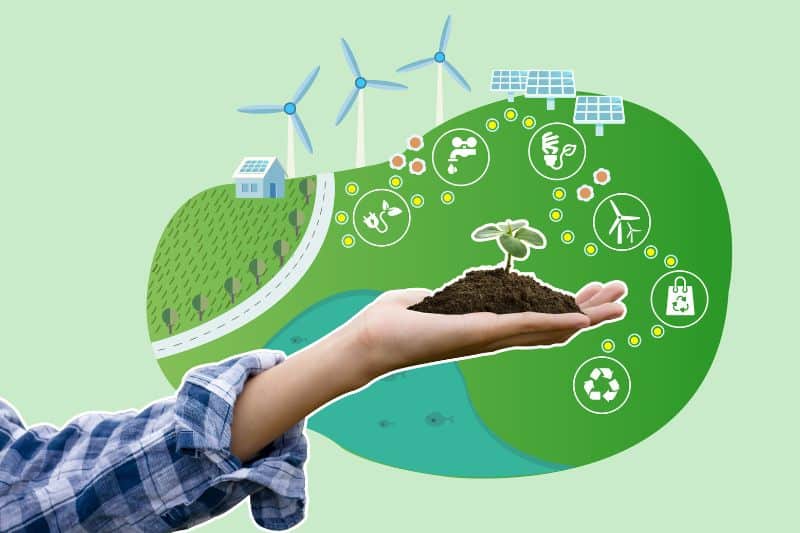In a growing world where the conventional forms of energy are fast moving towards extinction and contributing generously to global concerns like the greenhouse effect and global warming, the need to innovate and employ alternate or unconventional energy sources has become crucial for the existence of a future.
Waste-to-Energy, also widely recognized by its acronym WtE, is the generation of energy in the form of heat or electricity from waste. (The process is also called Energy from waste or EfW).
This process involves leveraging the developing technology to compress and dispose of waste while attempting to generate energy from it.
Each month, millions of tons of waste are produced. All this waste either becomes part of landfills or is exported to third-world countries, causing a huge environmental impact on wildlife, ecosystems, and human health.
Keeping this in mind, many new waste treatment plants have come up and have developed new ways to generate energy from landfill waste. This innovation not only provides energy but also helps reduce the pressure put on natural resources when producing energy using conventional ways.
Energy from waste offers energy recovery by converting non-recyclable materials through various processes, including thermal and non-thermal technologies.
The energy produced in the form of electricity, heat, or fuel using combustion, pyrolization, gasification, or anaerobic digestion is clean and renewable, with reduced carbon emissions and minimal environmental impact than any other form of energy. This makes EfW a more sustainable way of energy production.
But how exactly does this process happen? In this article, we will dig into the process of producing energy from waste. We will provide all the intricacies of this endeavor, so keep following!
How to Produce Energy From Waste?

‘Incineration’ is the most common and popular method for waste-to-energy generation. It is a highly debated technology due to the concerns it raises regarding safety and environmental impact.
For the uninitiated, incineration, in simple terms, is a type of waste treatment process where the organics from the waste collected are burnt at high temperatures.
Waste treatments that are conducted involving high temperatures are called Thermal Treatment, and the heat generated from this thermal temperature is then used to create energy.
Several countries in Europe, for instance, Sweden, Germany, and Luxembourg are experimenting with Incineration as an alternate means of energy production.
Thermal Technologies
Thermal technologies, as the name suggests, are those that use heat to generate energy from waste.
Notable examples include Depolymerization, gasification, pyrolysis, and plasma arc gasification.
Depolymerization
Depolymerization uses thermal decomposition and involves the heating of organic compounds at high temperatures in the presence of water. This process of thermal decomposition is called Hydrous Pyrolysis in scientific terms.
Often said to be a replication or representation of the conditions under which fossil fuels were created, Depolymerization has its own benefits and limitations.
Gasification
Gasification is yet another process employed for the same purpose and involves the converting of carbonaceous substances into carbon dioxide, carbon monoxide, and some amount of hydrogen.
Similar to incineration, this process utilizes elevated temperatures to achieve desired outcomes. However, a notable distinction sets it apart from incineration — specifically, the absence of combustion. Unlike incineration, this method does not involve the process of burning or combustion.
In this procedure, steam and/or oxygen take the place of conventional fossil fuels or organic substances. The resulting gas from this entire process is termed Synthesis gas, or syngas, representing a promising alternative energy source. Syngas finds extensive use, primarily in the production of heat and electricity, among various other applications.
Pyrolysis
The third way of getting energy from waste is called Pyrolysis, and is used mainly in industrial processes. It is just like Hydrous pyrolysis, or Depolymerization, albeit without the use of oxygen.
The term Pyrolysis, comes from the amalgamation of two Greek words, namely “pyr” meaning fire, and “lysis” meaning separating.
In essence, Pyrolysis represents the synthesis of these terms, capturing the concept of separating substances through the application of heat in the absence of oxygen.
Plasma Arc Gasification
The fourth way of generating energy from waste is Plasma arc gasification. As the name suggests, this process uses plasma technologies to obtain syngas or synthesis gas. A plasma torch is used to ionize the gas and thereafter, help obtain synthesis gas. The process generates electricity while compressing the waste.
Non-thermal Technologies

In contrast to the thermal technologies, non-thermal methods of generating energy from waste do not need the use of high temperatures.
Classical examples here include fermentation, anaerobic digestion, and the MBT technology. Let’s take a close look at each of these methods.
Fermentation
Fermentation is also being developed as a form of waste-to-energy management. The science of fermentation is known as zymology.
Fermentation is a metabolic process that, in biochemistry, is narrowly defined as the extraction of energy from carbohydrates in the absence of oxygen. It produces chemical changes in organic substrates through the action of enzymes.
In microorganisms, fermentation is the primary means of producing adenosine triphosphate (ATP) by degrading organic nutrients anaerobically. Humans have used fermentation to produce foodstuffs and beverages since the Neolithic age.
The method is used for preservation in a process that produces lactic acid in sour foods such as pickled cucumbers, kombucha, kimchi, and yogurt, as well as for producing alcoholic beverages such as wine and beer. Fermentation also occurs within the gastrointestinal tracts of all animals, including humans.
Anaerobic Digestion
Anaerobic digestion is a slow process. Here, microorganisms are used to destroy biodegradable content. No oxygen is present during this procedure. It is used both domestically and even on a commercial level to tap the release of energy during the process and use it.
Anaerobic technologies are seen as good agents to reduce the greenhouse gases from the atmosphere and a worthy replacement for fossil fuels. The process works as a boon for developing countries for creating low energies for cooking and lighting in homes.
Both China and India have mastered using this technology, employing it as a part of their respective development schemes and investing in it. Biogas is used to run a gas engine, and energy is created for small-scale use.
The MBT Technology
The MBT technology stands for Mechanical Biological treatment or mechanical biological pre-treatment and relates to a group of solid waste treatment systems.
The technology uses domestic, industrial, and commercial waste to generate products. These systems enable the recovery of materials contained within the mixed waste and facilitate the stabilization of the biodegradable component of the material.
The sorting component of the plants typically resembles a facility for materials recovery. This component is configured to recover the individual elements of the waste or produce a refuse-derived fuel that can be used for power generation. The components of the mixed waste stream that can be recovered include ferrous metal, non-ferrous metal, plastic, and glass.
Benefits of Waste to Energy (WtE)

Here are some of the benefits of the waste-to-energy process:
1. Reduction of Waste Going to Landfill Sites
The WtE reduces the expense of trash transportation and landfilling while, at the same time, it produces power. This reduces the amount of waste going to landfill sites and minimizes cost of transporting waste to landfills, as many significant landfills are fairly distant from the primary town hall.
2. Reduction of Greenhouse Gases
WtE initiative has a variety of ecological advantages. It generates much less and sometimes entirely avoids production of greenhouse gas, like methane; a greenhouse gas mainly sent out from decomposing the waste stream in landfills.
And just in case you didn’t know, methane gas is over 20 times more potent than carbon dioxide and is one of the most noteworthy contributors to climate modification.
Hence, by avoiding the production of methane in waste-to-energy facilities, we’re saving the planet and the same time making the most out of what we produce from in our everyday activities. Presently, these facilities in the US account for around 20% of renewable electricity generation.
3. Reduction in the Use of Fossil Fuels
The waste-to-energy process stays clear of the consumption of natural deposits like oil, gas, and coal, which are or else used to create energy. A solitary waste-to-energy center saves over 200,000 barrels of oil annually.
4. It is Environment-friendly

Electricity and heat can be generated from waste, providing an alternative and more environment-friendly energy source. Waste-to-energy is an emerging innovative set of technologies aimed at better sustenance of the environment, with minimum damage to the ecosystems.
With these technologies developing by the day and their acceptance increasing amongst households and industrial set-ups worldwide, waste-to-energy is seen as a development tool for emerging countries.
5. Creation of Jobs
The local community around these facilities benefits from the jobs created. The Power Recuperation Council states that the WTE sector supports approximately 14,000 jobs and $890 million in wages, salaries, and benefits. WTE facilities support local economies, buying goods and services from local vendors.
6. Better Recovery of Products
US WTE facilities recover more than 730,000 tons of ferrous metals for recycling. Communities that rely on WTE recycle more than the national average. WTE facilities recover metal for recycling that would have been buried forever if sent to a landfill.
7. Save Ecological Cycles
Waste to energy or energy from waste is a conscious attempt to equalize the patterns of our planet and save our ecological cycles. The energy generations from these technologies are small-scale right now, and their employment for domestic and industrial use is sparse. However, they are seen as the emerging solutions for tomorrow that are set to affect the world immensely.
Waste Energy Companies in USA
Covanta Energy (pronounced coh-van-tuh) is one of the world’s largest owners and operators of infrastructure for the conversion of waste-to-energy (known as “energy-from- waste” or “EfW”), as well as other waste disposal and renewable energy production businesses.
http://wheelabratortechnologies.com
Wheelabrator Technologies Inc. is a world leader in the safe and environmentally sound conversion of municipal solid waste – and other renewable waste fuels – into clean energy.
http://www.sierraenergycorp.com
Sierra Energy is a waste gasification and renewable energy company founded in Davis, California, in 2004. Sierra Energy commercializes in revolutionary FastOx waste gasification technology, a simple derivative of the centuries-old blast furnace technology.
EnerTech Environmental, Inc. is a renewable energy company dedicated to protecting public health and the environment through the development and commercialization of clean energy technologies for biosolids (sewage sludge) and other organic wastes.
http://www.zerowasteenergy.com
Zero Waste Energy is a development company that designs, builds, and operates integrated solid waste facilities throughout North America.
Tetronics International is a global leader in the supply of Direct Current (DC) Plasma Arc systems for a wide range of applications, including Waste Recovery, Hazardous Waste Treatment, Industrial Waste Treatment, Metal Recovery, Production Processes, and Nano Materials.
http://www.advancedplasmapower.com
Advanced Plasma Power Limited (APP) is the world leader in waste-to-energy and advanced fuel technology. APP is revolutionizing how we treat waste sustainably by maximizing the value of it as a source of materials and energy while also minimizing the impact of waste on the environment.
Whatever you intend to recycle or turn into an alternative fuel eFACTOR3 can provide a custom solution to meet your needs. This includes post-industrial waste, C&D waste, MSW (Municipal Solid Waste), post-consumer waste, paper and cardboard, Paper Sludge, wood, carpet, packaging film, agriculture film, plastic, or Biomass.
References:






